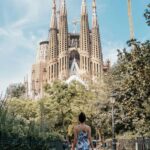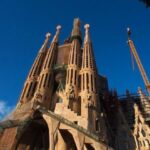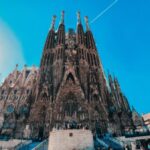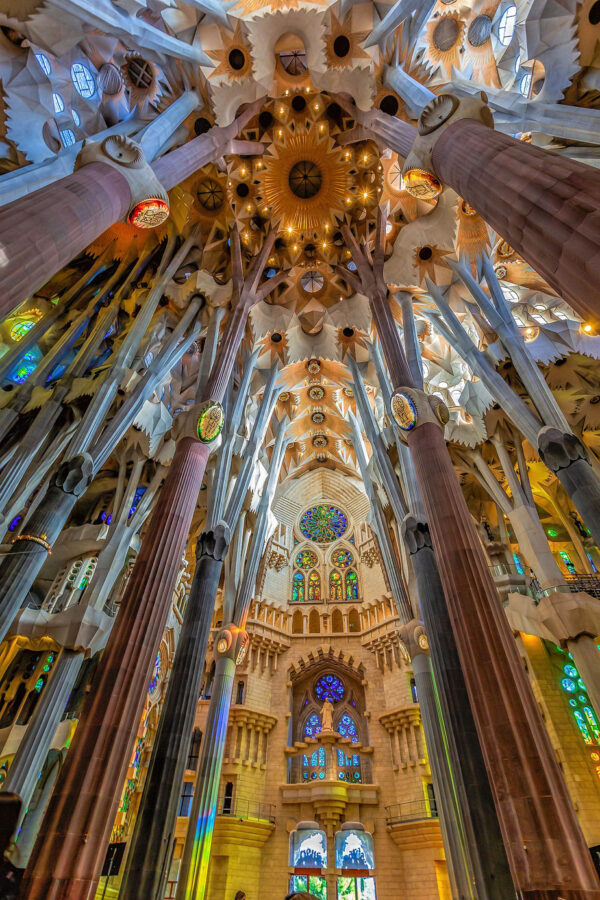
The Sagrada Familia, an iconic symbol of Barcelona, captivates visitors with its intricate design and towering spires. This basilica, a masterpiece by architect Antoni Gaudí, embodies a harmonious blend of nature and religion, making it a true architectural wonder.
In this article, we delve into **The Majestic Sagrada Familia: Exploring Barcelona's Architectural Marvel**, highlighting its unique features, historical significance, and the ongoing efforts to complete Gaudí's vision. Join us as we uncover the stories and inspirations behind this breathtaking structure that continues to inspire awe across the globe.
The History and Inspiration Behind the Sagrada Familia's Design
The history of the Sagrada Familia dates back to 1882 when construction began under architect Francisco de Paula del Villar. However, in 1883, Antoni Gaudí took over the project, infusing it with his distinctive style and profound vision. Inspired by the **natural world**, Gaudí aimed to create a structure that mirrored the organic forms found in nature, reflecting his belief that architecture should harmonize with the environment.
One of the key inspirations for the Sagrada Familia's design comes from Gaudí's deep **religious faith**. He envisioned the basilica not just as a church but as a catechism in stone, where every element serves a symbolic purpose. The intricate facades depict various biblical scenes, illustrating the life of Christ and the Virgin Mary, making the building a narrative piece of art. The **Passion, Nativity, and Glory** facades each convey different aspects of spirituality and humanity.
Gaudí's architectural style was greatly influenced by **Gothic and Art Nouveau** elements combined with his unique interpretations of geometry. He employed techniques such as hyperboloids and parabolas, which can be seen in the structure’s towering columns and spires. This innovative approach allows for a dynamic interplay of light and shadow within the basilica, creating an otherworldly atmosphere that enchants visitors.
Today, the Sagrada Familia remains a work in progress, with completion expected in the coming years. As we look at its ongoing construction, it’s crucial to recognize the meticulous craftsmanship and dedication of artisans who continue to bring Gaudí's vision to life. The basilica stands as a testament to human creativity, blending history, spirituality, and artistry in a way that continues to inspire generations.
A Detailed Look at the Architectural Styles of the Sagrada Familia
The architectural styles of the Sagrada Familia are a rich tapestry woven from various influences, primarily featuring Gothic and Art Nouveau elements. Gaudí's approach transcends traditional styles, creating a unique fusion that reflects his vision of a spiritual sanctuary. The basilica's soaring spires and intricate facades showcase a profound understanding of both structural engineering and aesthetic beauty, making it a living testament to his genius.
One notable aspect of the Sagrada Familia's design is its use of organic forms. Gaudí incorporated natural shapes into the structure, which is evident in the columns that resemble trees, branching out to support the roof. This method not only enhances the building's strength but also creates a sense of being enveloped by nature within the sacred space. The use of light and shadow further amplifies this effect, as sunlight filters through the stained glass, casting colorful patterns on the interior.
The facades of the Sagrada Familia are also significant in their architectural storytelling. Each facade—Nativity, Passion, and Glory—exhibits distinct stylistic features, such as:
- Nativity Facade: Richly decorated with scenes from the birth of Christ, showcasing a blend of Gothic and baroque styles.
- Passion Facade: Characterized by its stark, angular forms, reflecting the somber themes of Christ’s suffering.
- Glory Facade: Emphasizes the glory of the resurrection, featuring grand arches and lighter motifs.
In addition to these elements, Gaudí's innovative use of geometry is evident throughout the structure. By employing forms like hyperboloids and parabolas, he created a dynamic visual experience that challenges conventional architectural norms. This detailed approach not only enhances the basilica's structural integrity but also contributes to its ethereal atmosphere, inviting visitors to experience both awe and introspection.
Exploring the Symbolism in the Sagrada Familia's Facades
The Sagrada Familia's facades are not only architectural marvels but also profound symbols of faith and artistry. Each facade serves a unique narrative purpose, weaving together stories from the Bible while reflecting Gaudí's deep spiritual beliefs. This multi-layered symbolism invites visitors to engage with the building on both an aesthetic and an emotional level.
Among the distinct features of the Sagrada Familia's facades, the following stand out:
- Nativity Facade: A celebration of birth and life, this facade is adorned with intricate sculptures capturing joyful scenes from the Nativity, emphasizing the theme of hope and divine love.
- Passion Facade: This facade starkly contrasts with the Nativity, characterized by its raw, angular designs that evoke the suffering and sacrifice of Christ, urging reflection on the depths of human experience.
- Glory Facade: The culmination of Gaudí's vision, it embodies the resurrection and eternal life, with soaring arches that reach towards the heavens, symbolizing the ascent to divine glory.
The symbolism embedded in these facades extends beyond their artistic representations. Each element is meticulously crafted to convey theological concepts, making the Sagrada Familia a living catechism. Gaudí believed that architecture should serve a greater purpose, and through his designs, he communicated profound messages of faith and humanity.
Additionally, the use of natural motifs throughout the facades reflects Gaudí's belief in the interconnectedness of nature and spirituality. From the tree-like columns that support the structure to the intricate animal figures that adorn the facades, these elements serve as reminders of the divine presence in the natural world. This harmonious interplay between architecture and nature enhances the overall experience, inviting contemplation and wonder.
Visiting the Sagrada Familia: Tips for an Unforgettable Experience
When planning a visit to the Sagrada Familia, it's essential to arrive early to avoid long queues. As one of Barcelona's most popular attractions, the basilica can get crowded, especially during peak tourist seasons. Arriving at least 30 minutes before your scheduled entry allows you to soak in the atmosphere and take stunning photos of the exterior without throngs of people in the way.
For the best experience, consider booking a guided tour that includes access to the towers. An expert guide can provide fascinating insights into Gaudí's architectural vision and the basilica's intricate details, enriching your understanding of this architectural marvel. Additionally, climbing the towers offers breathtaking panoramic views of Barcelona, adding a unique perspective to your visit.
Don't forget to take your time exploring the interior, where the play of light through the stained glass windows creates a mesmerizing atmosphere. Plan to spend at least an hour inside, allowing yourself to appreciate the artistry and spiritual ambiance. To enhance your visit, consider the following tips:
- Purchase tickets online in advance to skip the lines.
- Visit during weekdays for a quieter experience.
- Bring a camera to capture the stunning details, but be respectful of the sacred space.
- Wear comfortable shoes, as you'll be walking and standing for extended periods.
Finally, as you explore the Sagrada Familia, take a moment to reflect on the profound symbolism embedded in its design. Gaudí intended for each element to convey a deeper spiritual message, making this basilica not just a visual feast but also a space for contemplation and inspiration. Embrace the experience, and let the unique blend of art and faith resonate with you long after your visit.
The Impact of Gaudí’s Vision on Modern Architecture
Antoni Gaudí's vision has left an indelible mark on modern architecture, inspiring countless architects to explore innovative designs that transcend traditional boundaries. His unique ability to blend **natural forms** with structural integrity has paved the way for organic architecture, where buildings are designed to harmonize with their surroundings. This movement encourages architects to incorporate elements of the natural world, creating spaces that resonate with both beauty and functionality.
One significant aspect of Gaudí's influence is his use of geometry, which has inspired a new generation of architects to experiment with complex shapes and forms. The incorporation of hyperboloids, parabolas, and other non-linear geometries allows for designs that are not only visually striking but also structurally sound. This approach has led to iconic structures worldwide that challenge conventional architectural norms and redefine the possibilities of construction.
Moreover, Gaudí's emphasis on **sustainability** has gained traction in contemporary architecture. His designs reflect an understanding of environmental considerations long before they became mainstream. By utilizing local materials and natural light, Gaudí demonstrated that architecture could be both ecologically responsible and aesthetically pleasing. This principle is increasingly relevant today as architects strive to create buildings that minimize their environmental impact while maximizing user experience.
In summary, Gaudí's visionary approach continues to resonate within the field of modern architecture, encouraging a blend of creativity, sustainability, and structural innovation. His work inspires architects to see beyond the conventional, inviting them to reimagine the spaces we inhabit and their relationship with the natural world. Through this ongoing dialogue, Gaudí's legacy remains a guiding force in the evolution of architectural design.
Sagrada Familia: A Testament to Barcelona’s Cultural Heritage
The Sagrada Familia stands as a testament to Barcelona's cultural heritage, embodying not only the artistic vision of Antoni Gaudí but also the historical and spiritual essence of the city. Its ongoing construction reflects a commitment to preserving this architectural jewel, while also adapting to contemporary needs. As visitors explore the basilica, they engage with a narrative that intertwines the past with the present, fostering a deeper appreciation for Barcelona's unique cultural identity.
This magnificent structure is also a symbol of collaboration among artists, architects, and craftsmen, all devoted to realizing Gaudí's ambitious vision. The Sagrada Familia showcases a multitude of influences that highlight the diversity of architectural styles present in Barcelona, including:
- Gothic elements: Demonstrated in the intricate detailing of the facades.
- Art Nouveau: Reflected in the organic forms and fluid lines throughout the design.
- Natural motifs: Emphasizing harmony with the environment.
As a living work of art, the Sagrada Familia serves as a focal point for cultural activities, hosting events that celebrate both local tradition and global significance. The basilica's integration into Barcelona's urban landscape has made it a central part of community life, drawing people together to share in their rich heritage. Its completion will undoubtedly mark a pivotal moment in the city's history, solidifying its status as a beacon of creativity and spiritual reflection.
Furthermore, the Sagrada Familia inspires future generations to engage with architecture as a means of storytelling and expression. It invites visitors to ponder deeper questions about faith, existence, and the natural world, cementing its place not just as a religious monument but as a vital part of Barcelona's cultural tapestry. Through every stone and spire, Gaudí's legacy continues to resonate, reminding us of the profound connection between art, faith, and community.
 Unveiling the Wonders Inside Barcelona's Sagrada Familia: A Journey Through Architectural Marvels
Unveiling the Wonders Inside Barcelona's Sagrada Familia: A Journey Through Architectural Marvels The Majestic Beauty of Sagrada Familia: Explore Barcelona's Official Website
The Majestic Beauty of Sagrada Familia: Explore Barcelona's Official Website The Complete Guide: Sagrada Familia in Barcelona - Finished Date, History and Must-See Attractions
The Complete Guide: Sagrada Familia in Barcelona - Finished Date, History and Must-See AttractionsIf you want to know other articles similar to The Majestic Sagrada Familia: Exploring Barcelona's Architectural Marvel you can visit the category WHERE YOU CAN GO.
Leave a Reply










Read more!